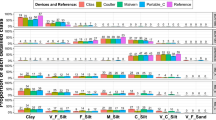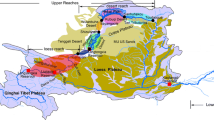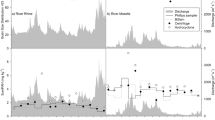Abstract
Purpose
There is a growing interest in the characterization of the particle size of sediment due to its impact on particle dynamics, especially for connectivity purpose. This study determined the particle size distribution of suspended sediment in a mountainous catchment, with the aim to evaluate the variability of particle size during floods, the main controlling factors, and if indirect information from hillslopes was useful for the interpretation of particle size measured at the catchment outlet. This work involved the development of a measurement protocol.
Material and methods
Samples were collected automatically from streamwater during flood events using an ISCO 3700 sampler. Five events were analyzed for their particle size distributions using a Malvern Mastersizer 2000. Because the samples were too concentrated, two different protocols were tested to address the errors made during the subsampling step: using a pipette and a home-made device with successive dilution phases.
Results and discussion
High errors occurred when using a pipette to extract particles within a stirred sample. The maximum errors were reduced from 1,600 to 30 % using the device described within this study. Particles were found to be aggregated at various levels regardless of the discharge they were sampled at. Their size was found to be either variable or stable at the event scale, and statistical analyses revealed that discharge was the factor that best correlated with particle size. The results obtained in this study are in agreement with the few other studies in comparable environments. Some hypothesis are put forward and discussed to explain the positive relationship between particle size and discharge. Input from hillslopes seems to have a measureable effect in this headwater catchment.
Conclusions
While the need for in situ measurements has long been stressed in lowland rivers, estuaries, and coastal environments, it was shown that the use of an accurate dilution protocol could provide some physically interpretable measurements on the particle size distributions of suspended sediment transported in a mountainous catchment. It also appears that hillslope information has to be considered when studying particle size measured at the catchment outlet.





Similar content being viewed by others
References
Accornero A, Gnerre R, Manfra L (2008) Sediment concentrations of trace metals in the Berre lagoon (France): an assessment of contamination. Archives Environ Contamin Toxicol 54:372–385
Agrawal YC, Pottsmith HC (2000) Instruments for particle size and settling velocity observations in sediment transport. Marine Geol 168:89–114
Beuselinck L, Govers G, Poesen J (1999) Assessment of micro-aggregation using laser diffractometry. Earth Surf Process Landforms 24:41–49
Brandt CJ (1990) Simulation of the size distribution and erosivity of raindrops and throughfall drops. Earth Surf Process Landforms 15:687–698
Chapman TG (1991) Comment on “Evaluation of automated techniques for base flow and recession analyses”. Wat Resour Res 27:1483–1484
Droppo IG (2001) Rethinking what constitutes suspended sediment. Hydrol Process 15:1551–1564
Droppo IG (2004) Structural controls on floc strength and transport. Can J Civ Eng 31:569–578
Droppo IG, Nackaerts K, Walling DE, Williams N (2005) Can flocs and water stable soil aggregates be differentiated within fluvial systems? Catena 60:1–18
Dyer KR (1989) Sediment processes in estuaries: future research requirements. J Geophysical Res 94:14327–14339
Fenessy MJ, Dyer KR (1996) Floc population characteristics measured with INSEEV during the Elbe estuary intercalibration experiment. J Sea Res 36:55–62
Francke T, López-Tarazón JA, Vericat D, Bronstert A, Batalla RJ (2008) Flood-based analysis of high magnitude sediment transport using a non-parametric method. Earth Surf Process Landforms 33:2064–2077
Haritashya UK, Kumar A, Singh P (2010) Particle size characteristics of suspended sediment transported in meltwater from the Gangotri Glacier, central Himalaya—an indicator of subglacial sediment evacuation. Geomorphology 122:140–152
Heng BCP, Sander GC, Armstrong A, Quinton JN, Chandler JH, Scott CF (2011) Modeling the dynamics of soil erosion and size-selective sediment transport over nonuniform topography in flume-scale experiments. Water Resour Res 47:W02513. doi:10.1029/2010WR009375
Kemp P, Sear D, Collins A, Naden P, Jones I (2011) The impacts of fine sediment on riverine fish. Hydrol Process 25:1800–1821
Kinnell PIA (2005) Raindrop-impact-induced erosion processes and prediction: a review. Hydrol Process 19:2815–2844
Lenzi MA, Marchi L (2000) Suspended sediment load during floods in a small stream of the Dolomites (northeastern Italy). Catena 39:267–282
López-Tarazón JA, Batalla RJ, Vericat D, Balasch JC (2010) Rainfall, runoff and sediment transport relations in a mesoscale mountainous catchement: The River Isábena (Ebro basin). Catena 82:23–34
Mikkelsen OA, Pejrup M (2001) The use of a LISST-100 laser particle sizer for in-situ estimates of floc size, density and settling velocity. Geo-Marine Lett 20:187–195
Milliman JD, Syvitski JPM (1992) Geomorphic/tectonic control of sediment discharge to the ocean: the importance of small mountainous rivers. J Geol 100:525–544
Navratil O, Esteves M, Legout C, Gratiot N, Nemery J, Willmore S, Grangeon T (2011) Global uncertainty analysis of suspended sediment monitoring using turbidimeter in a small mountainous river catchment. J Hydrol 398:246–259
Owens PN, Batalla RJ, Collins AJ, Gomez B, Hicks DM, Horowitz AJ, Kondolf GM, Marden M, Page MJ, Peackock DH, Petticrew EL, Salomons W, Trustrum NA (2005) Fine-grained sediment in river systems: environmental significance and management issues. River Res Applic 21:693–717
Petticrew EL (2005) The composite nature of suspended and gravel stored fine sediment in streams: a case study of O’Ne-eil Creek, British Columbia, Canada. In: Droppo IG, Leppard GG, Liss SN, Milligan TM (eds) Flocculation in natural and engineered environmental systems. CRC Press, Boca Raton, FL, pp 71–93
Phillips JM, Walling DE (1995) An assessment of the effects of sample collection, storage and resuspension on the representativeness of measurements of the effective particle size distribution of fluvial suspended sediment. Water Res 29:2498–2508
Phillips JM, Walling DE (1999) The particle size characteristics of fine-grained channel deposits in the River Exe Basin, Devon, UK. Hydrol Process 13:1–19
Phillips JM, Walling DE (2005) Intra-storm and seasonal variations in the effective particle size characteristics and effective particle density of fluvial suspended sediment in the Exe Basin, Devon, United Kingdom. In: Droppo IG, Leppard GG, Liss SN, Milligan TM (eds) Flocculation in natural and engineered environmental systems. CRC Press, Boca Raton, FL, pp 47–70
Rex JF, Petticrew EL (2010) Salmon-derived nitrogen delivery and storage within a gravel bed: sediment and water interaction. Ecol Eng 36:1167–1173
Slattery MC, Burt TP (1997) Particle size characteristics of suspended sediment in hillslope runoff and stream flow. Earth Surf Process Landforms 22:705–719
Stone PM, Walling DE (1997) Particle size selectivity considerations in suspended sediment budget investigations. Water Air Soil Pollut 99:63–70
Thonon I, Roberti JR, Middelkoop H, van der Perk M, Burrough PA (2005) In situ measurements of sediment settling characteristics in floodplains using a LISST-ST. Earth Surf Process Landforms 30:1327–1343
Walling DE, Moorehead PW (1989) The particle size characteristics of fluvial suspended sediment: an overview. Hydrobiologia 176(177):125–149
Walling DE, Owens PN, Waterfall BD, Leeks GJL, Wass PD (2000) The particle size characteristics of fluvial suspended sediment in the Humber and Tweed catchments, UK. Sci Total Environ 251(252):205–222
Williams ND, Walling DE, Leeks GJL (2007) High temporal resolution in situ measurement of the effective particle size characteristics of fluvial suspended sediment. Water Res 41:1081–1093
Williams ND, Walling DE, Leeks GJL (2008) An analysis of the factors contributing to the settling potential of fine fluvial sediment. Hydrol Process 22:4153–4162
Winterstein TA, Stefan HE (1986) Effects of nozzle orientation on sediment sampling. Proceedings of the Fourth Federal Interagency Sedimentation Conference, Subcommittee on Sedimentation of the Advisory Committee on Water Data, Las Vegas, Nevada, USA, 1, 1–20–1–28
Woodward JC, Porter PR, Lowe AT, Walling DE, Evans AJ (2002) Composite suspended sediment particles and flocculation in glacial meltwaters: preliminary evidence from Alpine and Himalayan basins. Hydrol Process 16:1735–1744
Woodward JC, Walling DE (2007) Composite suspended sediment particles in river systems: their incidence, dynamics and physical characteristics. Hydrol Process 21:3601–3614
Xu J (2002) Implications of relationships among suspended sediment size, water discharge and suspended sediment concentration: the Yellow River basin, China. Catena 49:289–307
Acknowledgments
This work was supported by the CNRS-INSU (EC2CO, CYTRIX) and STREAMS project (Sediment TRansport and Erosion Across Mountains), funded by the French National Research Agency (ANR/BLAN06-1_139157). We are grateful to the two anonymous reviewers for their comments on an earlier version of this article. C Duvert is also thanks for his helpful comments.
Author information
Authors and Affiliations
Corresponding author
Additional information
Responsible editor: William H. Blake
Rights and permissions
About this article
Cite this article
Grangeon, T., Legout, C., Esteves, M. et al. Variability of the particle size of suspended sediment during highly concentrated flood events in a small mountainous catchment. J Soils Sediments 12, 1549–1558 (2012). https://doi.org/10.1007/s11368-012-0562-5
Received:
Accepted:
Published:
Issue Date:
DOI: https://doi.org/10.1007/s11368-012-0562-5




